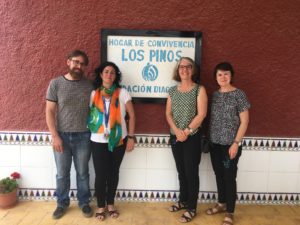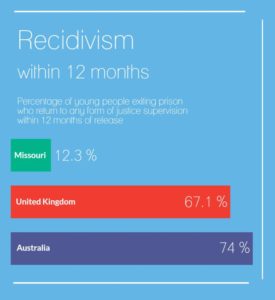Senior leaders at Jesuit Social Services recently went on a study tour to parts of Europe and USA in search of more humane responses to youth justice issues.

Jesuit Social Services CEO Julie Edwards (third from left) and Executive Director of Programs Sally Parnell (right) with staff from Diagrama in Spain
Over the past decade youth offending across Australia has decreased considerably, yet it remains at the forefront of public concern. Communities and media call for solutions, and politicians respond in turn, as they amplify the issue and position themselves for political incumbency.
Across Australia we now stand at a precipice, faced with a decision to leap off into the well-trodden but ineffective path of punitive justice – or to take a step back, collect our breath, look at what works and what doesn’t, and move forward with a clear vision.
With this in mind, Jesuit Social Services recently embarked on a Justice Solutions study tour to explore youth justice policy, practice, systems, facilities and advocacy in Europe and the United States; we are grateful that a long-term donor to Jesuit Social Services provided financial support for this study tour.
Throughout our travels we witnessed approaches to youth justice that were helping young people realise their potential, creating safer communities and saving tax-payers money.
Acknowledging that each system we viewed exists within its own unique context – some similar to our own and some vastly different – we came away with new ideas that must now be tested and adapted for use in Australia. What is clear viewing so many varied approaches is that successful models share common elements, all of which flow from a system that places the rehabilitation and re-socialisation of young people at its heart, whilst it holds them accountable and addresses their offending behaviours.
Successful systems operate in climates where youth crime and offending is not a fixation of public interest, the media, politicians and election campaigning. They focus on preventing young people from coming into contact with the justice system, using child-specific approaches and engaging families and communities. They have thorough assessment and planning processes that are supported by comprehensive social infrastructure and well-resourced community alternatives to locking young people up. When prison is necessary, it is focused on good education and building social and practical skills through programs that prepare young people for reintegration into their community. They use facilities that are small and close to the homes of detainees. They have positive, non-punitive cultures and well qualified staff who are committed to build relationships of trust.
All of this is underlined by deep commitment to take the time to hear the voices of young people and the voices of their families, to truly understand what’s driving their behaviour and ensure that those issues and needs are being addressed. The people and organisations we met with and learnt from urged us to consider that hasty and uninformed policy can derail a youth justice system, setting it off course for many years.
Now is the time for strong leadership. Our political leaders should work collaboratively, constructively and in good faith with experts in the field, service providers, academics, community members and most importantly young offenders and their families to develop a united vision for our youth justice system, and what sort of community we and future generations want to live in. We are pleased to note that the Victorian Government has recently accepted all recommendations included in a review by Penny Armytage and Professor James Ogloff and hope this can lead to positive reform.
Jesuit Social Services continues to stand ready to make a positive contribution to assist Governments across Australia to create safer communities and support young people to fulfil their potential.
Missouri
 The ‘Missouri model’ of youth detention is hailed as a revolutionary approach to meaningful reform which Australian states can learn from.
The ‘Missouri model’ of youth detention is hailed as a revolutionary approach to meaningful reform which Australian states can learn from.
Missouri’s youth detention facilities are small, home-like and based in local communities.
At the heart of Missouri’s approach is education. More than three-quarters (77 per cent) of young people in the system earn high school credits, compared to less than half (47 per cent) across the USA.
The success of this is demonstrated by an extremely low recidivism rate – 12 months after discharge, 87.7 per cent of young people have avoided further involvement with the justice system.
By contrast, in Australia 74 per cent of young people who leave detention have further involvement with the youth justice system within 12 months.
Germany
The general philosophy towards youth justice in Germany is to divert young offenders from the justice system wherever possible.
Crucially, when prison is necessary, young people are subjected to a four-week period of thorough assessment where an individual plan covering education and training, social needs and specific interventions (to address offending behaviour) is devised for their time in custody.
In contrast to Australia, the use of physical restraint, lockdown and isolation are extremely rare, with the focus always on treating any event as an opportunity to educate the person and build understanding and skills for life.
Norway
Norway has an extremely low incarceration rate due in no small part to the fact that the country has a strong social infrastructure – including good, free public health and education.
There is no stand-alone youth justice system in Norway. The age of criminal responsibility is 14 and young people 15 years and older are dealt with in the one justice system – but there are special facilities (a total of eight beds) for young people under 18 years who are imprisoned.
Across detention facilities, half the staff are social workers, half prison officers – and the latter are well qualified with two years training in areas including ethics, human rights, multicultural competence, psychology, sociology, criminology, law, social work, moral philosophy and re-integration.
Spain
The Diagrama Foundation is an international non-Government organisation, including being the largest provider of Youth Educational Centres in Spain – akin to youth detention facilities in the Australian context.
These centres focus on ‘relationships and boundaries’. Facilities are simple, and reflect young people’s ‘progression’ through stages of re-socialisation in readiness for reintegration back into the community. They are often built in rural surrounds and the principle of keeping young people as close to their families and local communities is a priority.
Children participate in five hours of school or vocational education each day, however Diagrama’s definition of education embraces building skills for life – including developing the capacity for respectful interaction with others, responsibility for your own behaviour and resolving conflict as well as the practical skills to live productive lives.





